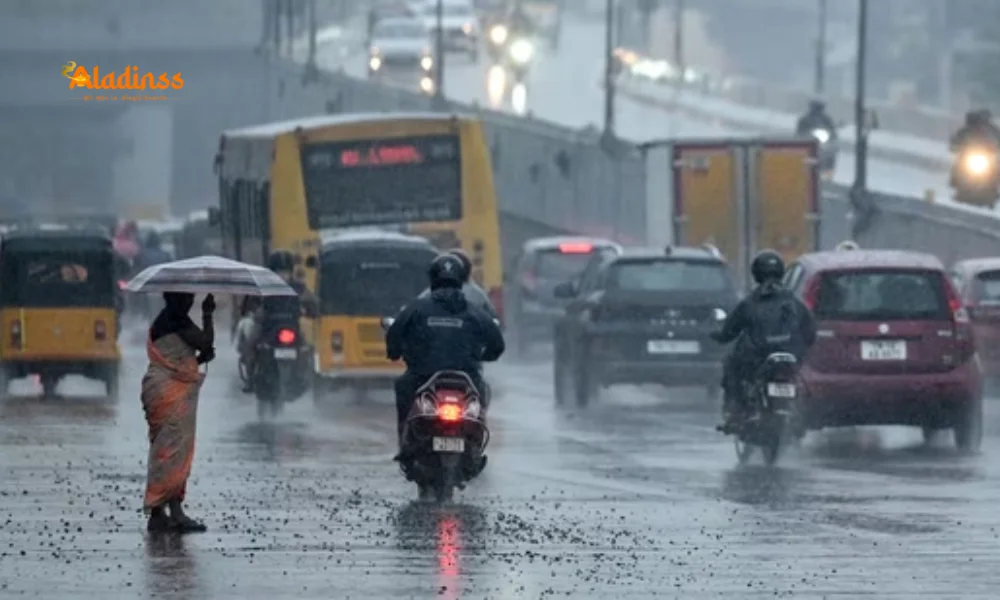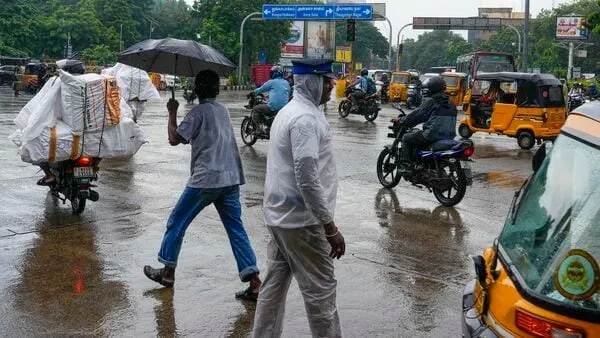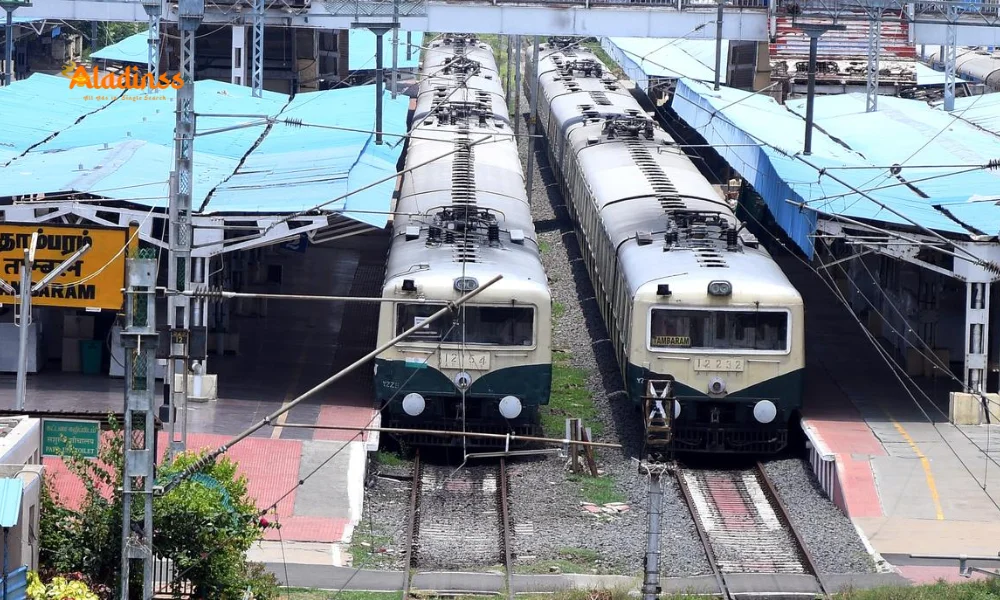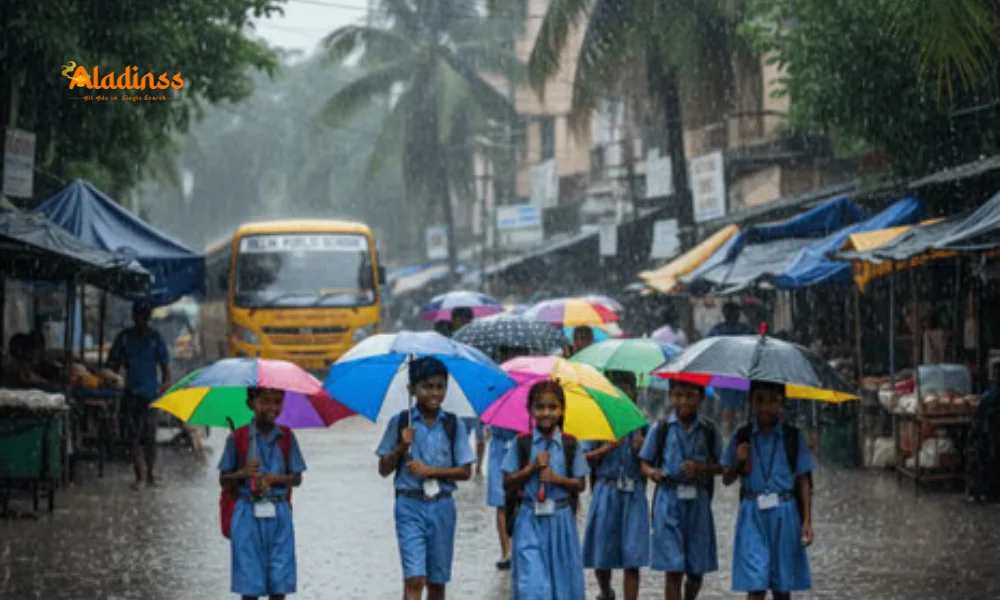Heavy Rain Hits Tamil Nadu IMD Issues Yellow Alert Across the State

Tamil Nadu Braces for Heavy Rain: IMD Issues Yellow Alert for Chennai, 4 Districts
Tamil Nadu is set to face persistent heavy rainfall in the coming days, with the India Meteorological Department (IMD) forecasting no immediate relief as the northeast monsoon intensifies. On October 23, 2025, the IMD issued a yellow alert for five districts, including Chennai, Tiruvallur, Kancheepuram, Chengalpattu, and Ranipet, warning of heavy rain at isolated locations. The ongoing downpour, which has battered parts of the state for days, is expected to continue until Tuesday, disrupting daily life and prompting authorities to take precautionary measures.
The heavy rainfall is driven by a cyclonic circulation off the Tamil Nadu coast, fueled by a low-pressure area in the Bay of Bengal. While this system is expected to weaken by Thursday evening, light to moderate rain with thunderstorms and lightning will persist across Tamil Nadu, Puducherry, and Karaikal. The Tamil Nadu weather alert highlights the need for residents to prepare for potential disruptions, including traffic delays and school closures, as seen in Dharmapuri district.
Yellow Alert for Five Tamil Nadu Districts
The IMD’s yellow alert for Chennai, Tiruvallur, Kancheepuram, Chengalpattu, and Ranipet signals the likelihood of heavy rainfall, defined as 64.5 mm to 115.5 mm in a 24-hour period. This alert underscores the intensity of the northeast monsoon, which typically brings significant rain to Tamil Nadu between October and December. Residents in these districts are advised to stay vigilant, as heavy rain could lead to waterlogging, traffic disruptions, and potential risks to infrastructure.
Chennai, a major metropolitan hub, recorded 97.9 mm of rainfall in the 24 hours ending at 8:30 AM on Wednesday, highlighting the severity of the ongoing monsoon. The city is expected to experience temperatures between 24°C and 31°C, with cloudy skies and intermittent showers. The IMD’s warning of thunderstorms and lightning adds to the challenges, urging residents to avoid open areas and ensure safety during adverse weather conditions.

Impact on Daily Life and Infrastructure
The persistent rainfall has already disrupted daily life across Tamil Nadu, with authorities taking proactive measures to mitigate its impact. In Dharmapuri district, Collector Satish declared a holiday for schools on Thursday due to the heavy downpour, prioritizing student safety. The IMD has also cautioned that traffic disruptions are likely, particularly in urban areas like Chennai, where waterlogging is a recurring issue during the monsoon season.
The heavy rainfall poses challenges for commuters, with roads in low-lying areas prone to flooding. Public transport systems, including buses and trains, may face delays, affecting office-goers, students, and daily wage workers. Authorities are urging residents to avoid unnecessary travel and stay updated on weather alerts to navigate the adverse conditions safely.
Understanding the Northeast Monsoon
The northeast monsoon, also known as the winter monsoon, is a critical weather event for Tamil Nadu, bringing the bulk of the state’s annual rainfall. Unlike the southwest monsoon, which primarily affects northern and western India, the northeast monsoon impacts southern states, particularly Tamil Nadu, Andhra Pradesh, and Karnataka. The IMD attributes the current heavy rainfall to a cyclonic circulation triggered by a low-pressure area in the Bay of Bengal, a common phenomenon during this season.
The IMD classifies rainfall as follows:
- Light rain: 2.5 mm to 15.5 mm in 24 hours.
- Moderate rain: 15.6 mm to 64.4 mm in 24 hours.
- Heavy rain: 64.5 mm to 115.5 mm in 24 hours.
- Very heavy rain: 115.6 mm to 204.4 mm in 24 hours.
- Extreme rain: Above 204.5 mm in 24 hours.
The current forecast indicates that Tamil Nadu will experience a mix of moderate to heavy rainfall, with isolated areas potentially seeing very heavy downpours. This variability underscores the need for preparedness, as sudden spikes in rainfall can lead to flash floods and other hazards.
Regional Weather Patterns and Relief Prospects
The IMD’s forecast extends beyond Tamil Nadu, predicting heavy to very heavy rainfall in neighboring regions, including Andhra Pradesh, Karnataka, Kerala, Mahe, Konkan, Goa, and the Andaman and Nicobar Islands. This widespread monsoon activity is driven by the same low-pressure system affecting Tamil Nadu, though the IMD expects this system to weaken by Thursday evening, potentially offering some relief to coastal areas.
In Tamil Nadu, the weakening of the low-pressure area may reduce the intensity of rainfall in some districts, but the IMD cautions that light to moderate rain will persist. Coastal areas, including Puducherry and Karaikal, are likely to experience thunderstorms and lightning, posing risks to residents and infrastructure. The Chennai weather forecast remains a focal point, given the city’s vulnerability to urban flooding during the monsoon season.
Preparedness and Safety Measures
Authorities across Tamil Nadu are taking steps to mitigate the impact of the heavy rainfall. The school closure in Dharmapuri is a proactive measure to ensure student safety, and similar actions may be taken in other districts if conditions worsen. Local governments are also working to clear drainage systems and prevent waterlogging, particularly in urban centers like Chennai, where flooding is a recurring challenge.
Residents are advised to follow these safety measures during the heavy rainfall:
- Stay Informed: Monitor IMD weather alerts and local news for updates on rainfall and potential hazards.
- Avoid Flooded Areas: Steer clear of waterlogged roads and underpasses to prevent accidents.
- Prepare for Power Outages: Keep emergency supplies, such as flashlights and batteries, ready in case of disruptions.
- Secure Property: Ensure that drainage systems around homes are clear to prevent flooding.
- Stay Indoors During Storms: Avoid open areas during thunderstorms to reduce the risk of lightning strikes.
These precautions are essential to ensuring safety and minimizing the impact of the monsoon on daily life. Local authorities are also deploying emergency response teams to handle potential crises, such as flash floods or infrastructure damage.
Economic and Social Implications
The heavy rainfall has significant implications for Tamil Nadu’s economy and society. Agriculture, a key sector in the state, relies heavily on the northeast monsoon for water supply, but excessive rainfall can damage crops and disrupt planting schedules. Farmers in affected districts are urged to take protective measures to safeguard their fields from flooding.
In urban areas, the Tamil Nadu heavy rainfall disrupts businesses, particularly small enterprises and street vendors, who face reduced footfall during adverse weather. The closure of schools and potential disruptions to public transport further impact daily wage workers and families, highlighting the need for robust disaster management strategies to support vulnerable communities.
Government Response and Long-Term Planning
The Tamil Nadu government is actively responding to the monsoon challenges, with district administrations coordinating efforts to manage the impact of heavy rainfall. In Chennai, civic authorities are focusing on improving drainage infrastructure to prevent urban flooding, a persistent issue during the monsoon season. Investments in flood mitigation projects, such as stormwater drains and desilting canals, are critical to reducing the city’s vulnerability.
Long-term planning is also essential to address the challenges posed by climate change, which is intensifying monsoon patterns. The state government is working with the IMD to enhance early warning systems and improve disaster preparedness. Community awareness campaigns are being rolled out to educate residents on safety measures and the importance of staying informed during extreme weather events.
Looking Ahead: Monsoon Outlook
As the northeast monsoon continues, Tamil Nadu residents must brace for more rainfall in the coming days. While the weakening low-pressure system may offer temporary relief, the IMD’s forecast of sustained rain until Tuesday indicates that vigilance remains crucial. Coastal districts, in particular, face heightened risks due to their proximity to the Bay of Bengal, where cyclonic activity can escalate rapidly.
The IMD’s proactive issuance of weather alerts and the government’s response measures demonstrate a commitment to minimizing the impact of the monsoon. However, the success of these efforts depends on community cooperation and the timely implementation of infrastructure improvements. As Tamil Nadu navigates this challenging weather period, staying prepared and informed will be key to ensuring safety and resilience.
Comment / Reply From
No comments yet. Be the first to comment!











